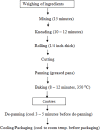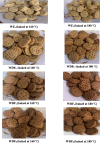Quality attributes of date and wheat flour pineapple juice blended cookies as affected by different baking temperatures
- PMID: 36852224
- PMCID: PMC9961095
- DOI: 10.7717/peerj.14876
Quality attributes of date and wheat flour pineapple juice blended cookies as affected by different baking temperatures
Abstract
Studying the effects of temperature on cookies are necessary especially if the impact on quality attributes are to be deduced. More so, blending wheat flour, date flour, and pineapple juice could improve the nutrient quality required in modern-day cookies. This current study investigated the quality attributes of date and wheat flour pineapple juice blended cookies as affected by different baking temperatures. With pineapple juice serving as water substitute, the formulated date, and wheat flour blends adhered to the following ratios: 100:0, 90:10, 80:20, and 70:30. Baking cookies involved two different temperatures (160 °C and 180 °C) with constant time (30 min). Quality attributes determined proximate composition, micronutrients, physical and functional properties, and microbial and sensory qualities. Cookies proximate results showed moisture (6.89-7.40%), protein (8.73-10.22%), fat (14.37-15.99%), fiber (1.02-1.11%), ash (0.77-1.20%) and carbohydrate (64.85-67.71%). Various ranges appeared, from energy values (434.90-444.10 kcal), minerals (calcium = 33.18-62.45 mg/100 g; iron = 3.47-5.75 mg/100 g; potassium = 100.07-358.63 mg/100 g), vitamins (vitamin A =1.99-4.89 mg/100 g; vitamin C = 0.04-0.15 mg/100 g), physical (weight = 7.4-7.75 g; diameter = 3.50-4.01 cm; thickness = 0.99-1.20 cm; volume = 3.11-3.77 cm3; density = 2.06-2.41 g/cm3; spread ratio = 2.92-4.05 cm3), to functional (water absorption = 1.14-1.18 g/g; oil absorption capacity = 1.31-1.33 g/g; bulk density = 0.74-0.76 g/mL) properties. The microbial loads seemed somewhat acceptable as overall acceptability favoured sample WDFb (90% wheat, 10% date flour). The acceptability of cookies baked at 160 °C over those baked at 180 °C suggests the need for further studies to determine the energy requirements, and long-term environmental implications such (baking) temperatures would pose.
Keywords: Cookies; Date flour; Energy value; Moisture; Pineapple juice; Wheat flour.
© 2023 Okoyeuzu et al.
Conflict of interest statement
Charles Odilichukwu R. Okpala is an Academic Editor at PeerJ.
Figures



References
-
- Abdel ME, Sulieman IA, Elhafise A, Awad MA. Comparative study of five Sudanese date (Phoenix dactylifera L.) fruit cultivars. Food and Nutrition Sciences. 2012;3:1245–1251. doi: 10.4236/fns.2012.39164. - DOI
-
- Ade Kuldip D, Lal A, Mishra AA. Development and quality evaluation of pineapple pomace and wheat bran fortified biscuits. The Allahabad Farmer Journal. 2015;70(2):57–60.
-
- Ajibola FC, Oyerinde OV, Adeniyan SO. Physicochemical and antioxidant properties of whole wheat biscuits incorporated with Moringa oleifera leaves and cocoa powder. Journal of Scientific Research and Report. 2015;7(3):195–206. doi: 10.9734/JSRR/2015/18070. - DOI
-
- Al-daihan S, Bhat RS. Antibacterial activities of extracts of leaf, seed, and bark of Phoenix dactylifera. African Journal of Biotechnology. 2012;11(42):10021–10025. doi: 10.5897/AJB11.4309. - DOI
-
- American Association of Cereal Chemists . Approved methods of American Association of Cereal Chemists. Tenth Edition. St. Paul, Minnesota: American Association of Cereal Chemists; 2000. pp. 276–280.
Publication types
MeSH terms
Substances
LinkOut - more resources
Full Text Sources
Research Materials
Miscellaneous

